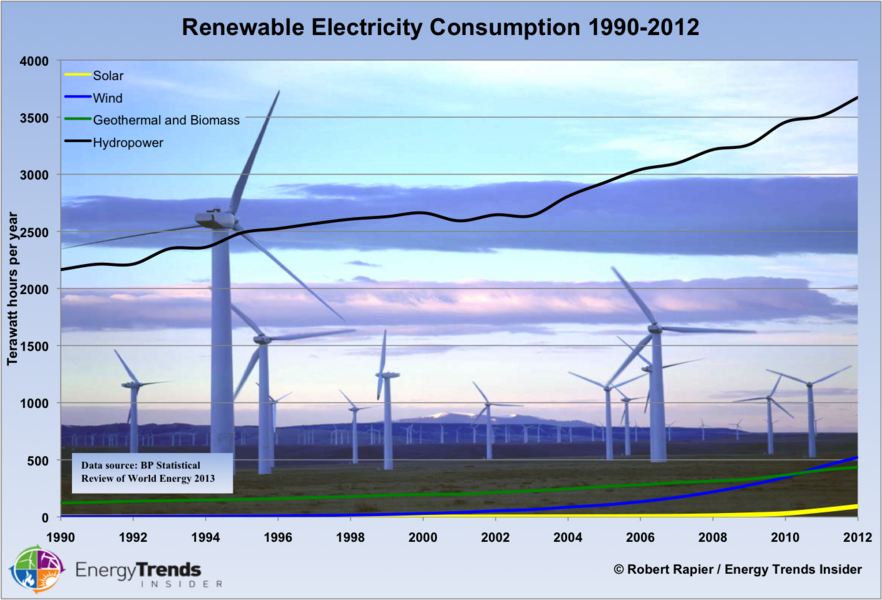Hydropower: the unsung hero of renewable energy
Loading...
This is the 2nd installment in a series that looks at the recently released 2013 BP Statistical Review of World Energy. The previous post – Renewable Energy Status Update 2013 – focused mainly on wind and solar power. This post delves into hydropower and geothermal power. Some of the BP data is supplemented by REN21′s recently-released 2013 Renewables Global Status Report (GSR). (Disclosure: I have been a reviewer for the GSR for the past three years).
Hydropower
Hydropower accounts for more electricity production than solar PV, wind, and geothermal combined. In 2012, hydropower accounted for 16% of the world’s electricity production. However, hydropower gets far less press because it is a mature technology with a much lower annual growth rate than most renewables. While solar PV increased capacity by an average of 60% per year over the past 5 years, new hydropower capacity increased at a much more modest annual rate of 3.3%.
However, since 1). The installed base for hydropower is so high; and 2). The capacity factors for hydropower tend to be much higher than those for intermittent renewables — the amount of hydropower produced dwarfs that of the other renewable options. (The capacity factor is simply the amount of power produced divided by the power that would be produced if the power source was producing at full capacity at all times). Between 2002 and 2012, the amount of hydropower consumed globally increased by more than 1,000 terawatt hours (TWh). Over that same period of time, the amount of wind and solar power consumed increased by 560 TWh — albeit at a much higher annual rate of growth.
The capacity of hydropower plants also dwarfs that of other renewables such as wind and solar. In fact, the four largest power plants in the world are all hydropower plants. The only non-hydropower plant in the Top 5 is the Kashiwazaki-Kariwa Nuclear Power Plant in Japan, which is the world’s 5th largest power plant.
Despite hydropower’s current dominant position among renewables, growth in consumption of hydroelectricity will likely continue to be modest, because many of the best sites for hydroelectric dams have already been developed. The exception to this is in the Asia Pacific region, where hydroelectric consumption more than doubled over the past decade. The region currently accounts for 35% of global hydroelectric consumption, and that percentage is likely to increase as countries continue to develop hydroelectric power plants.
Geothermal
The BP Statistical Review lumps geothermal and biomass power together, presumably because they are both considered firm power options. (Firm power is simply power that is supposed to be available as needed, as opposed to intermittent power which may only be available when the sun shines or the wind blows). As a result, the BP data is supplemented with the REN21 report to isolate the geothermal contribution.
Geothermal energy is energy obtained from the earth’s internal heat. It is one of the most environmentally benign sources of energy, producing little to no emissions during normal operation. Like hydropower, geothermal electricity is a relatively mature renewable technology, which is reflected by its modest 4% annual growth rate over the past 5 years.
Geothermal electricity is produced when heat from within the earth is used to produce steam, which is then passed through a turbine. Electricity produced in this way generally requires fairly shallow geothermal reservoirs (less than 2 miles deep). Geothermal electricity has a high capacity factor, and the cost of generation is comparable to that of coal-fired generation.
Geothermal energy can be also be used for heating or cooling. Hot springs or water circulating in hot zones can be used to heat buildings. Geothermal heat pumps take advantage of the earth’s temperature a few feet below the ground—consistently 50° to 60°F—to heat buildings in the winter and cool them in the summer.
In 2012, at least 78 countries used geothermal directly for energy. Over two-thirds of the geothermal energy for direct use was through geothermal heat pumps. 24 countries operated geothermal plants for electricity production. Total geothermal electricity capacity was 11.7 GW at the end of 2012. Capacity was led by the U.S. with 3.4 GW of capacity, followed by the Philippines at 1.9 GW, Indonesia at 1.3 GW, Mexico at 1.0 GW, and Italy at 0.9 GW. On a per capita basis, Iceland leads the world with 0.7 GW of capacity, which accounted for 30% of the country’s electricity in 2012.
The largest producer of geothermal power in North America is Calpine (NYSE: CPN), which operates 15 geothermal power plants at The Geysers region of Northern California. The 725 megawatts of geothermal power produced there represent about 40% of the North American total. The largest producer of geothermal power in the world, however, isn’t a company that many people might guess. It is Chevron (NYSE: CVX), which pioneered the development of The Geysers, and today operates geothermal plants in Indonesia and the Philippines.
Conclusions
Hydropower and geothermal power will continue to make important contributions to the world’s renewable energy portfolio, but they are unlikely to see the kinds of growth rates likely to be experienced by solar power over the next decade. Geothermal power still produces more electricity globally than solar PV, but was passed up by wind power in recent years. However, hydropower will likely continue its leading role as the world’s most important producer of renewable electricity until well into the next decade.
Link to Original Article: Hydropower and Geothermal Status Update 2013








